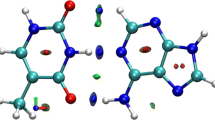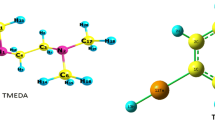Abstract
A novel molecular connectivity index, \( ^{m} \chi \prime \), based on the adjacency matrix of molecular graphs and novel atomic valence connectivities, \( \delta ^{\prime }_{i} \), for predicting the molar diamagnetic susceptibilities of organic compounds is proposed. The \( \delta ^{\prime }_{i} \) is defined as: \( \delta _{i} \prime = \delta _{i} ^{v} \cdot {E_{i} } \mathord{\left/ {\vphantom {{E_{i} } {12.625}}} \right. \kern-\nulldelimiterspace} {12.625} \), where \( \delta ^{v}_{i} \) and Ei are the atomic valence connectivity and the valence orbital energy of atom i, respectively. A good QSPR model for molar diamagnetic susceptibilities can be constructed from \( ^{0} \chi \prime ,^{1} \chi \prime ,^{2} \chi \prime \) and \( ^{4} \chi ^{\prime }_{p} \) using multivariate linear regression (MLR). The correlation coefficient r, standard error, and average absolute deviation of the MLR model are 0.9918, 5.56 cgs, and 4.26 cgs, respectively, for the 721 organic compounds tested (training set). Cross-validation using the leave-one-out method demonstrates that the MLR model is highly reliable statistically. Using the MLR model, the average absolute deviations of the predicted values of molar diamagnetic susceptibility of another 360 organic compounds (test set) is 4.34 cgs. The results show that the current method is more effective than literature methods for estimating the molar diamagnetic susceptibility of an organic compound. The MLR method thus provides an acceptable model for the prediction of molar diamagnetic susceptibilities of organic compounds.

Plot of calculated vs experimental values of molar diamagnetic susceptibilities using the multivariate linear regression (MLR) model (Eq. 8)


Similar content being viewed by others
References
Atkins AT (1986) Physical chemistry, 3rd edn. Oxford University Press, Oxford, p 699
Sellwood PW (1956) Magnetochemistry, Interscience, New York
Dorfman YG (1965) Diamagnetism and the chemical bond. Arnold, London
Vulfsan SG (1998) Molecular magnetochemistry. Gordon & Breach, Amsterdam
Simion DV, Sorensen TS (1996) J Am Chem Soc 118:7345–7352
Ania F, Balta-Calleja FJ (1992) Stud Phys Theor Chem 77:527–554
Katsuki A, Tokunaga R, Watanabe S, Tanimoto Y (1996) Chem Lett 607–608
Mccarthy MJ, Zion B, Chen P, Ablett S, Darke AH, Lillford PJ (1995) J Sci Food Agric 67:13–20
Ligabue A, Soncini A, Lazzeretti P (2002) J Am Chem Soc 124(9):2008–2014
Putz MV, Russo N, Sicilia E (2003) J Phys Chem A 107(28):5461–5465
Hameka HF (1961) J Chem Phys 34:1996–2000
O’Sullivan PS, Hameka HF (1970) J Am Chem Soc 92:25–32
O’Sullivan PS, Hameka HF (1970) J Am Chem Soc 92:1821–1824
Stockham ME, Hameka HF (1972) J Am Chem Soc 94:4076–4078
Haley LV, Hameka HF (1974) J Am Chem Soc 96:2020–2024
Segal GA (1977) Semiempirical methods of electronic structure calculation: applications, vol 8. Part B. Modem theoretical chemistry. Plenum, New York
Pollock EL, Runge KJ (1992) J Chem Phys 96:674–680
Romera E, Dehesa JS (1994) Phys Rev A 50:256–266
Sulzbach HM, Schleyer PV, Jiao HJ, Xie YM, Schaefer HF (1995) J Am Chem Soc 117:1369–1373
De Luca G, Russo N, Sicilia E, Toscano M (1996) J Chem Phys 105:3206–3210
King JW, Molnar SP (1997) J Quantum Chem 64:635–645
Kier LB, Hall LH (1976) Molecular connectivity in chemistry and drug research. Academic, New York
Schmalz TG, Klein DJ, Sandleback BL (1992) J Chem Inf Comput Sci 32:54–57
Li LF, Zhang Y, You XZ (1995) J Chem Inf Comput Sci 35:697–700
Estrada E (1998) J Chem Soc Faraday Trans 94:1407–1410
Estrada E, Gutierrez Y (1999) J Chromatogr A 858:187–199
Estrada E, Gutierrez Y, González H (2000) J Chem Inf Comput Sci 40:1386–1399
You XZ (1992) Structure and properties of coordination compounds. Science, Beijing
Wiener H (1947) J Am Chem Soc 69:17–20
Randić M (1975) J AmChem Soc 97:6609–6615
Kier LB, Hall LH (1986) Molecular connectivity in structure–activity analysis. Research Studies, Letchworth, England
Klein DJ (1986) Int J Quant Chem S20:153–171
Balaban AT (1992) J Chem Inf Comput Sci 32:23–28
Mu LL, Feng CJ (2003) Chin J Chem Phys 16:19–24
Feng CJ (2000) Chin J Chem Phys 13:66–70
Feng CJ (2002) Chin J Anal Sci 18:27–32
Feng CJ (1999) Chin J Mol Sci 15:223–228
Feng CJ, Chen Y (2000) Chin J Mol Sci 16:177–183
Mu LL, Feng CJ, He HM (2006) MATCH Commun Math Comput Chem 56:97–111
Mu LL, He HM, Feng CJ (2006) Chin J Chem 24:855–861
Qing ZL, Feng CJ (2002) Chin J Anal Sci 18(4):303–305
Feng CJ, Yang WH (2005) Chin J Chem Res 16(2):88–92
Mu LL, Feng CJ, He HM (2007) MATCH Commun Math Comput Chem 58 (3):591–607
Mu LL, He HM, Feng CJ (2007) Chin J Chem 25:743–750
Nie CM, Wen SN, Li ZH, Xie SB, Wang HQ (2002)Acta Chim Sin 60(2):207–214
David RL, Grace B, Lev IB, Robert NG, Henry VK, Kozo K, Gerd R, Dana LR, Daniel Z (2002) CRC Handbook of Chemistry and Physics, 85th edn. CRC, Boca Raton, pp 4.143–4.148
Yao YB, Xie T, Gao YM (1985) Handbook of Physical Chemistry. Shanghai Technology, Shanghai, pp 247–276
Lawrence VH, Hendrik FH (1974) J Am Chem Soc 96(7):2020–2024
Hyp JDJ, James DW, John LL (1969) J Am Chem Soc 91(8):1991–1998
González MP, Helguera AM, Cabrera MA (2005) Bioorg Med Chem 13:1775–1781
González MP, Dias LC, Helguera AM, Rodriguez YM, De Oliveira LG, Gomez LT, Diaz HG (2004) Bioorg Med Chem 12:4467–4475
Molina E, Diaz HG, González MP, Rodriguez E, Uriarte E(2004) J Chem Inf Comput Sci 44:515–521
González MP, Gonzalez Diaz H, Molina Ruiz R, Cabrera MA, Ramos de Armas R (2003) J Chem Inf Comput Sci 43:1192–1199
González MP, Terán C, Fall Y, Diaz LC, Morales AH (2005) Polymer 46:2783–2790
Saiz-Urra L, González MP, Teijeira M (2006) Bioorg Med Chem 14:7347–7358
Saiz-Urra L, González MP, Teijeira M (2007) Bioorg Med Chem 15:3565–3571
Acknowledgments
This work is supported by the University Natural Science Foundation of Jiangsu Province in China (contract grant number: 04KJD150195). The authors express our gratitude to the referees for their value comments.
Author information
Authors and Affiliations
Corresponding author
Rights and permissions
About this article
Cite this article
Mu, L., Feng, C. & He, H. Topological research on diamagnetic susceptibilities of organic compounds. J Mol Model 14, 109–134 (2008). https://doi.org/10.1007/s00894-007-0256-x
Received:
Accepted:
Published:
Issue Date:
DOI: https://doi.org/10.1007/s00894-007-0256-x




